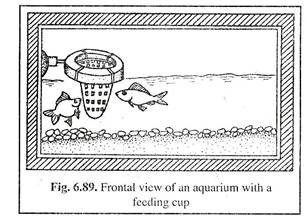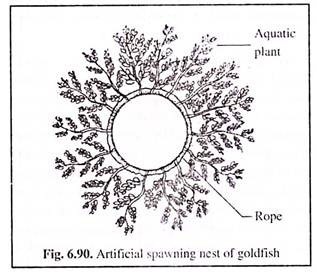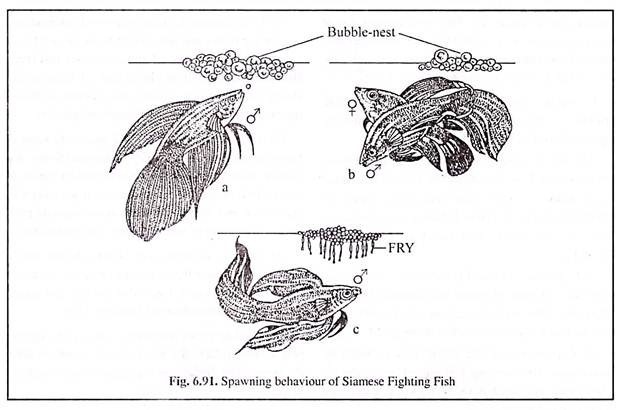In this article we will discuss about Ornamental Fishes:- 1. Criteria for Selection of Ornamental Fishes 2. Food and Feeding of Ornamental Fishes 3. Breeding.
Criteria for Selection of Ornamental Fishes:
While selecting suitable aquarium fishes it is essential to follow the following lines:
(1) Aquarium fishes selected should be attractive and brilliantly coloured.
(2) Selected species should be compatible to each other.
ADVERTISEMENTS:
(3) Fishes introduced into the aquarium should be healthy, disease-free and should be collected from reliable sources.
(4) Fishes that are sluggish should be avoided. Behaviour of the fishes should be lively with well-spread fins and should be actively swimming.
(5) The sizes of the fishes kept in the aquarium should be uniform (as far as possible), as larger fishes may harm the smaller ones.
(6) Fishes should be brought from the aquarium shop in properly packed, well-oxygenated polythene water bags kept at normal temperature.
ADVERTISEMENTS:
(7) Initially only 5 to 6 fishes of choice should be introduced gently into the aquarium. Avoid adding a number of fishes within a short period and also avoid overcrowding
Food and Feeding of Ornamental Fishes:
For better growth and survival of aquarium fishes it is essential to provide them with mixed and balanced diet. Algae which often grow on the pebbles, glass panes and in water of the aquarium, serve as a good source of food for sword tails, kissing gouramis and mollies.
Various protein-rich live fish food such as Cyclops, Daphnia, Rotifers, Tubifex, earthworms, mosquito larvae, chironomid larvae, artemia nauplii, etc. are considered as excellent food.
Freshly chopped earthworm, shrimp, fish paste, scraped boiled fish or raw liver are also considered as good food items. Of great use to aquarists are the commercially prepared dried food meant only for aquarium fishes which is easily available from requisite shops.
ADVERTISEMENTS:
The dried food generally constitutes a mixture of cereal, milk powder, prepared egg, dried Daphnia, fish or shrimp. These are dried, powdered and mixed together and formed into pellets or flakes.
Liver is high in protein, rich in iron and contains vitamins. Raw liver, however, should be avoided as it will make the water cloudy. So the liver is put into boiling water for a minute to coagulate the blood. The liver is then chopped into small cubes and is shreded in a blender.
Shreded shrimps can also be added to it to improve the food quality. Hard boiled egg yolk can also form useful food. Wheat-germ can also be given from time to time as it contains large amount of Vitamin B. Adequate amount of Calcium, Phosphorus and iodine should also be given to the fishes to prevent ill health and shunted growth.
A feeding ring which is in the form of a square or a circle is used for confining the dry feeds within the ring, which thus helps —
(1) To avoid the spreading of the dried feed all over the water surface and
(2) In allowing the excess feed to fall at the bottom in one place only.
The cup-shaped feeding device (Fig. 6.89) attached to the ring, is meant only for tubifex worms.
Aquarium fishes should be fed with different types of food for better health and growth. It is advisable to feed them less but often. Aquarium fishes are generally fed twice a day. However, fishes can remain without food for nearly two weeks.
Identification of a Healthy Ornamental Fish:
ADVERTISEMENTS:
In an aquarium healthy fishes can be easily recognized through the following observations:
(1) They should be active and feed well.
(2) Their fins should be erect.
(3) Their body colour should be good and glazy.
(4) There should be no spots or blemishes on the skin.
(5) The eyes should be bright and the colour of the gills red or pink.
(6) The body cavity of the fishes should not be swollen and no skeletal deformities.
Breeding of Ornamental Fishes:
In nature, fishes are stimulated by changes in environmental factors which are difficult to extend in captivity. However, such conditions, to some extent, can be stimulated in the aquaria by providing specific biological requirement for spawning. Some fishes breed naturally with ease while others have to be bred by artificial techniques such as hypophysation and hand stripping.
The native aquarium fishes, which have high demand overseas, are harvested from their natural sources (i.e., from the wild). However, overharvesting of these priced native fish species may lead (in the long run) to a depletion of the stock and many such species have been pushed to the brink of extinction.
Hence, captive breeding of such economic ornamental fishes is very important not only for a sustainable trade of these species but also to conserve the natural stock. Breeding of popular exotic species is also undertaken to meet the high demand of the local aquarium fish market.
The various aspects of breeding comprise selecting the breeding pair, conditioning the brood fishes, observing spawning and raising its young. According to the breeding habits of fish, the breeding tanks have to be prepared.
Fishes either produce egg or live young. Egg layers comprises egg-scatterers, egg depositors, egg buriers (bubble-nest builders), mouth brooders, nest builders, etc. In live-bearing fishes live youngs are released by the females.
(a) Identification of sexes:
In the case of live- bearers identification of sexes is essential. The mature males of egg-layers develop ‘pale-tubercles’ or small ‘bumps’-like white spots or cysts on the head, gill cover and pectoral fin which make the male rough to touch. They ooze milt when pressure is applied on the belly. The mature female has a ‘gravid spot’ on the vent, and the belly is comparatively swollen.
(b) Selection of breeding pair:
A breeding pair is selected that are already showing courting behaviour, when they show interest to each other. The fishes are brought to condition through feeding with good quality food particularly the live food. In case of egg-layers, male fishes often show too much interest in females and they need to be separated after spawning.
(c) Egg-layers or oviparous:
Fertilisation is external in oviparous fishes. The fry of these fishes are small and helpless whey they hatch. The egg- layers depending on the type of eggs laid, may be of two types — (i) Adhesive eggs which have the ability to attach to any substratum and (ii) Non-adhesive eggs.
Another method of dividing the egg layers of ornamental fishes is according to their spawning habit. They are of the following types:
(i) Egg scatterers:
The egg scatterers, such as Zebra Danio, Goldfish, etc., show little or no parental care. Fishes like Siamese Fighter Fish have a tendency to eat up their own eggs when they are released. So the eggs or the fishes should be removed to another tank after spawning gets over. In the wild, the eggs probably get hidden in the muddy water or are swept away by the water current.
In an aquarium, the eggs are provided with some egg saving measures, such as:
(1) A layer of marble chips or pebbles are provided at the bottom, in which the eggs may lie concealed.
(2) In case of fishes which releases adhesive eggs (Ex. common carp), thick bunches of plants or mops of nylon wool may be provided in the breeding tank.
(3) For further safeguard of the eggs, a net may be kept submerged in the water, below the breeders, through which the eggs may pass through to the tank bottom.
Goldfish breeding:
Although goldfish (Carassius aural us) has a lifespan of 10 years, the male and female mature in the first and second years, respectively. The selected breeders are segregated sex-wise. At the time of breeding two males and one female are released into the breeding aquarium, which has been erected for the purpose.
For collection of the eggs, artificial spawning nests are made of small branches of aquatic plants tied on a circular rope, as shown in Fig. 6.90. At the time of mating, the males chases the female and pre-spawning intimation takes place. The eggs laid by the females are fertilised by the milt of the males. The fertilised eggs being adhesive and demersal, stick to the spawning nest.
This nest with attached eggs is then taken out of the breeding tank and transferred to the nearby hatching tank. In a period of three days hatching takes place and the hatchlings initially subsists on the available yolk.
After two days (when the yolk has become exhausted), they are fed with mashed particles of hard-boiled egg yolk seived through a muslin cloth or on small sized zoo-plankton and nauplii of artemia. It has been seen that enhanced feeding takes place only at a high temperature of about 35°C.
(ii) Egg depositors:
The egg depositors, such as Rasbora doniconius, Hemichronis bimaculatus, Aequidens sp. etc., show highest degree of parental care. They are the most important group among the egg-layers and unlike the egg-scatterers these fishes do not eat their own eggs.
They select sites such as filter tube, glass wall or plant leaf for laying the eggs. The Cichlid fishes deposit their eggs in a hole dug at the bottom. Before spawning the egg depositors forcibly evict any other fish from the surrounding area by chasing them away.
(iii) Egg burriers:
The egg burriers, such as Aplocheilus panchax, are annual fishes, as they survive only for a year in the wild and never live to see the fate of their offsprings. In the wild, the adult fishes spawn before the onset of summer. They bury their eggs in the mud bed so that they can survive the forthcoming dry season when the bed dries up. With the onset of monsoon, the eggs hatch out.
In the aquarium, however, the condition is different as the water never dries out and most of the fishes live longer than one year. The eggs are laid in dense planted environment inside the aquarium. As the eggs are capable of remaining viable, hatching is possible even after some weeks or even months.
(iv) Mouth brooders:
The female tilapia, being a mouth brooder, picks up the fertilized eggs into its mouth and incubates them in its throat. Even after hatching, the female tilapia carries the spawn and young ones in its mouth. During this incubation period of two weeks, the female does not take any food.
(v) Nest builders:
The gouramis (Colisa lalia, C. fasciata, etc.) and their relatives are the most popular among the nest builders. The male generally builds the nest and also guards the eggs from any intruders including the female.
Bubble-nest builder:
The bubble-nest is made by the male next to a floating leaf or among the floating plants. The males of Siamese fighters (Betta splendens), gourami, etc. forms the nest by frequently rising to the surface, gulping atmospheric air and enveloping it with mucus formed in the mouth during spawning to form a bubble (Fig. 6.91a). Several such bubbles adhere to one another to form a raft or float.
The male then drives the female near to the raft, flexes around her (Fig. 6.91b) and fertilises few eggs released by the female. The fertilised eggs sink slowly to the bottom. Both fishes then drift downwards. The male picks up the eggs and blows them into the nest.
The courting and mating behaviour is repeated until the female is empty of eggs. The male, at this stage, becomes aggressive even towards the female and, if not removed, will certainly kill it.
The male guards the eggs until it hatches. Some of the hatched fry (Fig. 6.9 1c) fall out and spiral away to the bottom. They are picked up by the male and blown back into the group. After five days when the fry starts to swin, the male fish is then removed. The fry is then fed with infusoria or finely sieved egg yolk for a few days, after which they are given freshly hatched brine shrimp, Daphnia and chopped worms.
(d) Live bearers of ovoviviparous:
The Live-Bearers due to their beautiful and bright colouration find a special place for the ornamental fish hobbyists. They also have an easy breeding habit. The live-bearers directly release the young ones. The eggs of these fishes are fertilised internally in the belly pouch of the female.
After one copulation, the female collects the sperms which is enough to fertilise 2 to 3 batches of eggs. The pregnant females are then separated in a brood cage, through which the young can escape when born. This is done because the live-bearers are known to be cannibalistic and feed on their young ones. The breeding tanks may be provided with plants for the safety of the young ones.
In India the live-bearing fishes are generally of exotic origin. Some of the common live-bearers are Guppy (Poecilia reticulatua), Molly (Mollienisia latipinna), Sword tail (Xiphophorus helleri), Platy (X. maculates), etc.
(e) Feeding of fry:
Food should not be given to the new brood until they are able to consume it, because the unconsumed food would decay and pollute the tank. The fry of live-bearers are able to feed immediately, but the young ones of egg-laying fishes would often remain immobile for several hours while they consume the remainder of their yolk sac.
Commercially available fry food can be had in aquarium shops and is available in liquid or powdered form. The size of the particles should be such that the fry can eat it. Generally brine shrimp, microworms and Infusoria can be fed to new fry. Infusoria are a collection of ciliated protozoans that can be produced in the laboratory.
Boiling water i s poured over chopped dry hay or green lettuce leaves in ajar. The mixture is kept in a warm, dark place for a few days. A healthy broth of Infusoria will be produced floating in the Sun. Small quantities of the infusoria can be added, several times a day for feed of the new fry.


